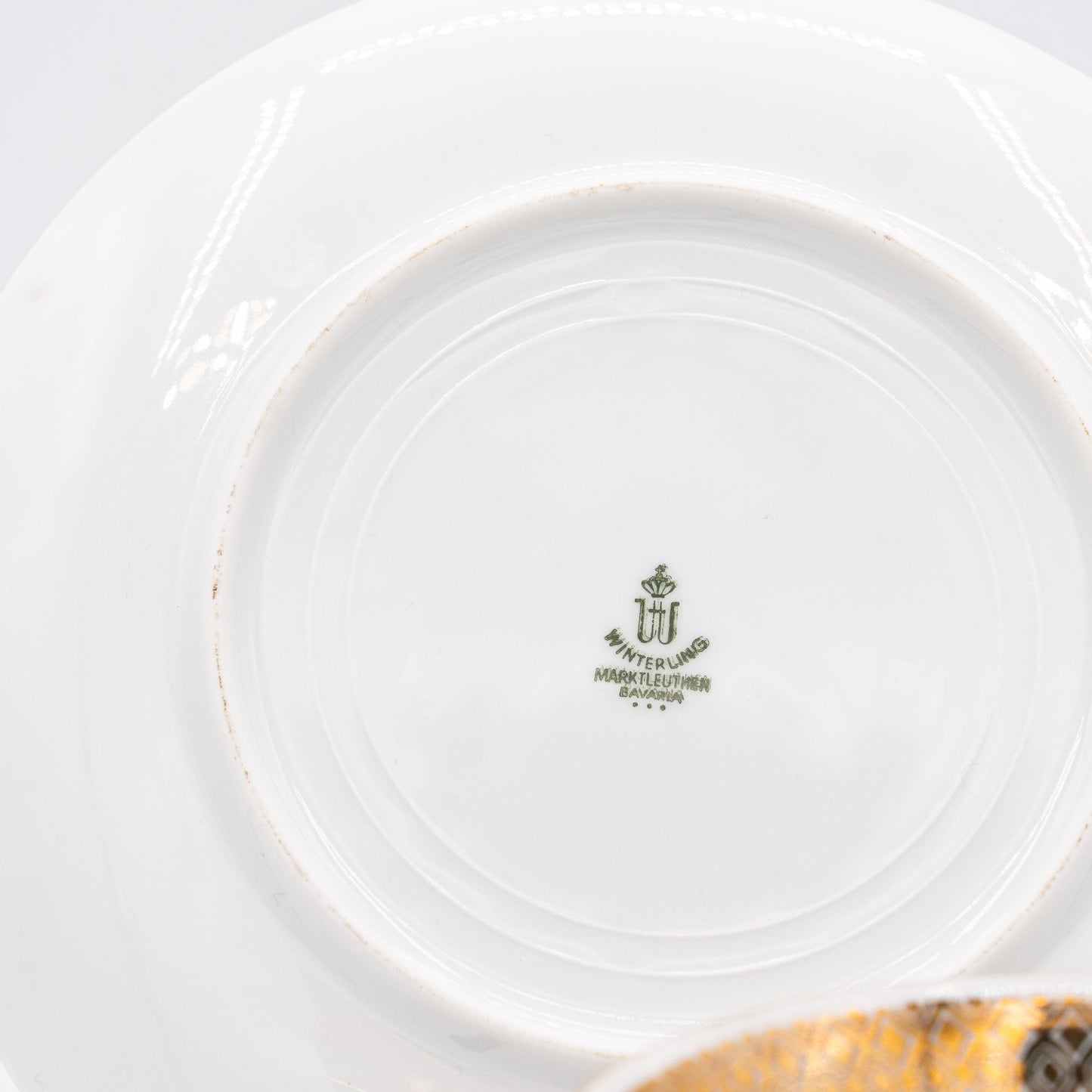Winterling
Mid-Century Teacup, Saucer and Plate Set - Orange Mandala - Winterling Röslau - 1950s
Mid-Century Teacup, Saucer and Plate Set - Orange Mandala - Winterling Röslau - 1950s
Couldn't load pickup availability
Celebrate the golden age of German coffee culture with this luminous 1950s Winterling Sammeltasse from Marktleuthen, Bavaria. The conical cup, saucer, and cake plate are banded with a refined gold lattice and a jewel-bright mandala rosette, finished with gleaming gilt foot and handle - a glamorous mid-century trio made for Kaffee und Kuchen.
In post-war West Germany, “Sammeltasse” (literally “collector’s cup”) referred to single, especially decorative tea trios - cup, saucer, and dessert plate - sold individually rather than as full services.
They became beloved gifts for confirmations, birthdays, and weddings during the 1950s–60s boom years, when Bavarian factories such as Winterling, Rosenthal, and Hutschenreuther paired modern forms with lavish gold and fashionable colours.
Today, they’re cherished for their chic silhouettes and nostalgic elegance.
- Material: Fine porcelain with transfer and hand-applied gilt
- Style: Mid-Century Modern (Sammeltasse trio)
- Place of Origin: Bavaria / Germany
-
Date of Manufacture: c.1950s (post-war “Wirtschaftswunder” period)
- Mark: Printed Winterling Röslau Bavaria Germany crown mark to bases (as photographed)
- Condition: Very good vintage condition. Light, honest surface wear from gentle use; minor rubs to gilding on rim/handle consistent with age. No cracks; no hairlines. Please check all photos.
Dimension:
LADY SIZE Cup Height: 5 cm | 1.9 in
Diameter Saucer: 15 cm | 5.9 in
Diameter Plate: 19.5 cm | 7.6 in
Share
- Worldwide Shipping
- Secure Packaging
- Loving Curation







Origin & Maker
Founded in 1906 in Röslau, Bavaria, Gebrüder Winterling began as a small family-owned porcelain factory by Heinrich and Ferdinand Winterling .
The company swiftly expanded - acquiring fellow chinaware maker Oscar Schaller in 1917, opening new plants in Kirchenlamitz (1920) and Windischeschenbach (1929).
By the 1930s, Winterling had grown into one of Germany’s top porcelain producers, known for elegant tableware, classic patterns like the iconic “Indian Blue,” and even branching into stoneware by the 1960s. A formal corporation in 1950, Winterling reached its peak before declaring bankruptcy in 2000.
Today, Winterling pieces are cherished reminders of a golden era in Bavarian porcelain craftsmanship.
Blog posts
View all-

A Serendipitous Morning at the Rue de Bretagne ...
There are few joys in life that match the thrill of stumbling upon a hidden treasure, and for me, flea markets hold that magical allure. One of my favourite flea...
A Serendipitous Morning at the Rue de Bretagne ...
There are few joys in life that match the thrill of stumbling upon a hidden treasure, and for me, flea markets hold that magical allure. One of my favourite flea...
-

Emile Bourgeois and "Le Grand Dépôt" in Paris
Recently, I found this stunning Sarreguemines wash set. It was at the Brocante in Belfort, France. On this day, we had got up at 4 AM to be there in...
Emile Bourgeois and "Le Grand Dépôt" in Paris
Recently, I found this stunning Sarreguemines wash set. It was at the Brocante in Belfort, France. On this day, we had got up at 4 AM to be there in...
-

The Legacy of Robert Haviland: A Journey from N...
The story of Robert Haviland porcelain is one of artistry, transatlantic ambition, and enduring heritage. It begins in the mid-19th century when David Haviland, an enterprising New Yorker, founded Haviland...
The Legacy of Robert Haviland: A Journey from N...
The story of Robert Haviland porcelain is one of artistry, transatlantic ambition, and enduring heritage. It begins in the mid-19th century when David Haviland, an enterprising New Yorker, founded Haviland...










